The NVIDIA GeForce RTX 2080 Ti & RTX 2080 Founders Edition Review: Foundations For A Ray Traced Future
by Nate Oh on September 19, 2018 5:15 PM EST- Posted in
- GPUs
- Raytrace
- GeForce
- NVIDIA
- DirectX Raytracing
- Turing
- GeForce RTX
Power, Temperature, and Noise
With a large chip, more transistors, and more frames, questions always pivot to the efficiency of the card, and how well it sits with the overall power consumption, thermal limits of the default ‘coolers’, and the local noise of the fans when at load. Users buying these cards are going to be expected to push some pixels, which will have knock on effects inside a case. For our testing, we use a case for the best real-world results in these metrics.
Power
All of our graphics cards pivot around the 83-86W level when idle, though it is noticeable that they are in sets: the 2080 is below the 1080, the 2080 Ti sits above the 1080 Ti, and the Vega 64 consumes the most.
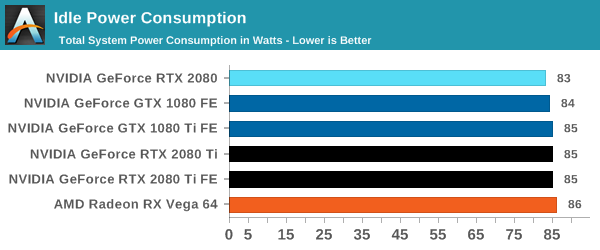
When we crank up a real-world title, all the RTX 20-series cards are pushing more power. The 2080 consumes 10W over the previous generation flagship, the 1080 Ti, and the new 2080 Ti flagship goes for another 50W system power beyond this. Still not as much as the Vega 64, however.
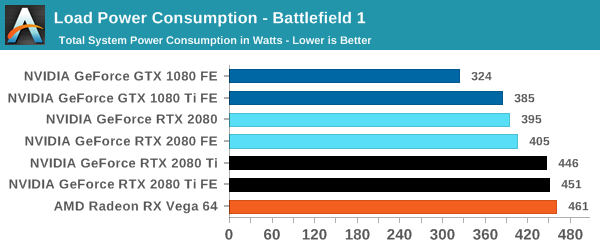
For a synthetic like Furmark, the RTX 2080 results show that it consumes less than the GTX 1080 Ti, although the GTX 1080 is some 50W less. The margin between the RTX 2080 FE and RTX 2080 Ti FE is some 40W, which is indicative of the official TDP differences. At the top end, the RTX 2080 Ti FE and RX Vega 64 are consuming equal power, however the RTX 2080 Ti FE is pushing through more work.
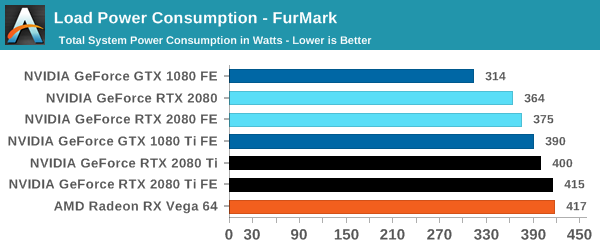
For power, the overall differences are quite clear: the RTX 2080 Ti is a step up above the RTX 2080, however the RTX 2080 shows that it is similar to the previous generation 1080/1080 Ti.
Temperature
Straight off the bat, moving from the blower cooler to the dual fan coolers, we see that the RTX 2080 holds its temperature a lot better than the previous generation GTX 1080 and GTX 1080 Ti.
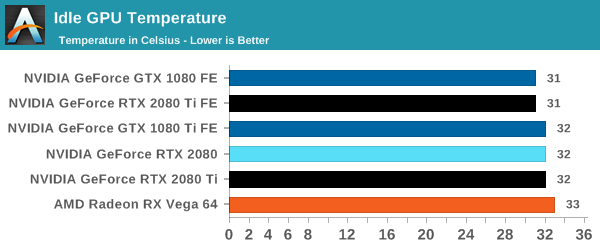
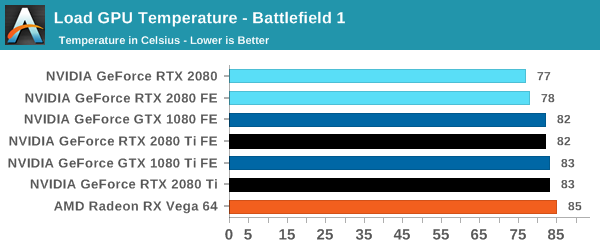
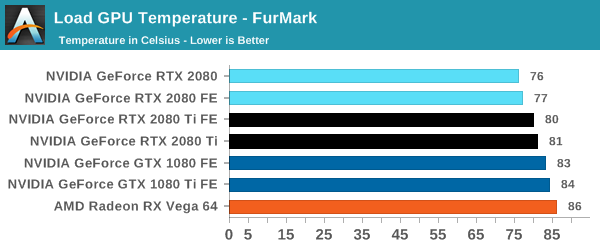
At each circumstance at load, the RTX 2080 is several degrees cooler than both the previous generation and the RTX 2080 Ti. The 2080 Ti fairs well in Furmark, coming in at a lower temperature than the 10-series, but trades blows in Battlefield. This is a win for the dual fan cooler, rather than the blower.
Noise
Similar to the temperature, the noise profile of the two larger fans rather than a single blower means that the new RTX cards can be quieter than the previous generation: the RTX 2080 wins here, showing that it can be 3-5 dB(A) lower than the 10-series and perform similar. The added power needed for the RTX 2080 Ti means that it is still competing against the GTX 1080, but it always beats the GTX 1080 Ti by comparison.
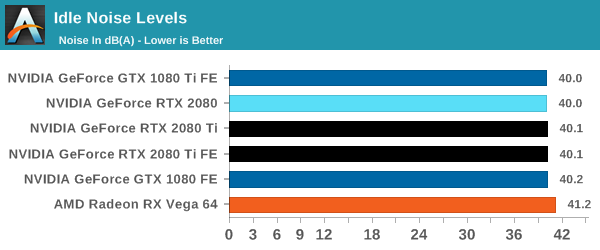
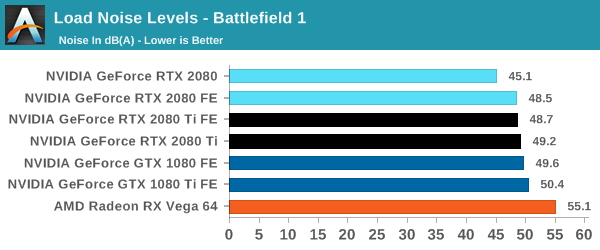
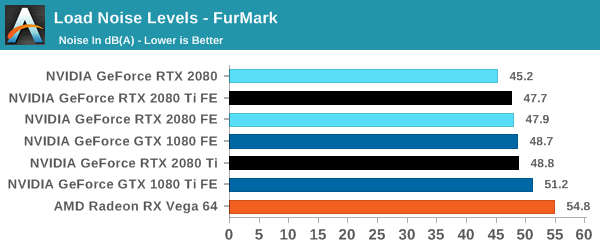










337 Comments
View All Comments
nevcairiel - Thursday, September 20, 2018 - link
Technically AMD would have to hit a 70-80% advancement at least once over their own cards at least if they ever want to offer high-end cards again.Arbie - Thursday, September 20, 2018 - link
Why gratuitously characterize all those complaining of price as "AMD fanboys"? Obviously, most are those who intended to buy the new NVidia boards but are dismayed to find them so costly! Hardly AMD disciples.Your repeated, needless digs mark you as the fanboy. And do nothing to promote your otherwise reasonable statements.
eddman - Thursday, September 20, 2018 - link
I'm such an AMD fanboy that I have a 1060 and have never owned an AMD product. You, on the other hand, reek of pro nvidia bias.A 40% higher launch MSRP is not "how it always works out".
No one is complaining about the performance itself but the horrible price/performance increase, or should I say decrease, compared to pascal.
Moore's law? 980 Ti was made on the same 28nm process as 780 Ti and yet offered considerably higher performance and still launched at a LOWER MSRP, $650 vs. $700.
Inteli - Saturday, September 22, 2018 - link
Got enough straw for that strawman you're building? The last 3 GPUs I've bought have been Nvidia (970, 1060, 1070 Ti). I would have considered a Vega 56, but the price wasn't low enough that I was willing to buy one.News flash: in current games, the 2080 is tied with the 1080 Ti for the same MSRP (and the 1080 Ti will be cheaper with the new generation launches). Sure, if you compare the 1080 to the 2080, the 2080 is significantly faster, but those only occupy the same position in Nvidia's product stack, not in the market. No consumer is going to compare a $500 card to a $700-800 card.
The issues people take with the Turing launch have absolutely nothing to do with either "We only got a 40% perf increase" or "Nvidia raised the prices" in isolation. Every single complaint I've seen is "Turing doesn't perform any better in current games as an equivalently priced Pascal card".
Lots of consumers are pragmatists, and will buy the best performing card they can afford. These are the people complaining about (or more accurately disappointed by) Turing's launch: Turing doesn't do anything for them. Sure, Nvidia increased the performance of the -80 and -80 Ti cards compared to last generation, but they increased the price as well, so price/performance is either the same or worse compared to Pascal. Many people were holding off on buying new cards until this launch, and in return for their patience they got...the same performance as before.
mapesdhs - Wednesday, September 26, 2018 - link
Where I live (UK), the 2080 is 100 UKP more expensive than a new 1080 Ti from normal retail sources, while a used 1080 Ti is even less. The 2080 is not worth it, especially with less RAM. It wouldn't have been quite so bad if the 2080 was the same speed for less cost, but being more expensive just makes it look silly. Likewise, if the 2080 Ti had had 16GB that would at least have been something to distinguish it from the 1080 Ti, but as it stands, the extra performance is meh, especially for the enormous cost (literally 100% more where I am).escksu - Thursday, September 20, 2018 - link
Lol.....most important??If you think that ray tracing on 2080ti is damm cool and game changer.....You should see what AMD has done. Just that no one really care about it back then.....
https://forums.geforce.com/default/topic/437987/th...
Even more incredible is that this was done 10yrs ago on 4870x2....REAL TIME......Yes, I repeat, REAL TIME.......
nevcairiel - Thursday, September 20, 2018 - link
It was just another "rasterization cheat" though, may have looked nice but ultimately didn't have the longevity that Ray Tracing may have. No 3D developer or 3D artist is going to ever argue that Ray Tracing is not the future, the question is just how to get there.V900 - Thursday, September 20, 2018 - link
Meh... The image itself is captured by cameras, it’s the manipulation of it that’s done in real time.Which is of course a neat little trick; and while it looks good, it’s hardly as impressive and computationally demanding as creating a whole image through raytracing.
escksu - Thursday, September 20, 2018 - link
https://www.cinemablend.com/games/DirectX-11-Ray-T...AMD did that again with 5870.... REAL TIME......but nobody cares........because the world only bothers about Nvidia.........
Chawitsch - Thursday, September 20, 2018 - link
The demos you linked to are beautiful indeed, however both the ATi Ruby demo and Rigid Gems demo use standard DirectX feature from those times, no ray tracing at all or any vendor specific features. Due to the latter it is worth pointing out that the 2008 Ruby demo (called Double Cross IIRC) was perfectly happy to run on nVidia cards of the time.If these demos show anything, it is that there were and are extremely talented artists out there who can do amazing things to work around the limitations of rasterization. This way however we can always merely approximate how a scene should look, with increasingly high costs, so going back to proper ray tracing was only a question of when its costs will approach that of rasterization. We seem to have arrived at the balancing point, hence hybrid rendering. I also think if AMD could have pushed nVidia more with high end GPUs, nVidia may not have made this step at this time, at least it certainly could have been a more risky proposition otherwise.